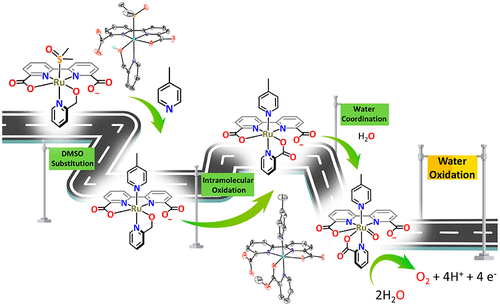当前位置:
X-MOL 学术
›
Inorg. Chem.
›
论文详情
Our official English website, www.x-mol.net, welcomes your
feedback! (Note: you will need to create a separate account there.)
A Ru-bda Complex with a Dangling Carboxylate Group: Synthesis and Electrochemical Properties
Inorganic Chemistry ( IF 4.3 ) Pub Date : 2020-03-10 , DOI: 10.1021/acs.inorgchem.9b03595 Abolfazl Ghaderian 1, 2 , Jan Holub 1 , Jordi Benet-Buchholz 1 , Antoni Llobet 1, 3 , Carolina Gimbert-Suriñach 1
Inorganic Chemistry ( IF 4.3 ) Pub Date : 2020-03-10 , DOI: 10.1021/acs.inorgchem.9b03595 Abolfazl Ghaderian 1, 2 , Jan Holub 1 , Jordi Benet-Buchholz 1 , Antoni Llobet 1, 3 , Carolina Gimbert-Suriñach 1
Affiliation

|
Ruthenium complexes containing the tetradentate 2,2′-bipyridine-6,6′-dicarboxylato (bda2–) equatorial ligand and ortho-subsituted pyridines in the axial position have been prepared and characterized using spectroscopic, crystallographic and electrochemical techniques. Complexes [Ru(Hbda)(DMSO)(pyC)] (1) and [Ru(bda)(DMSO)(pyA)] (2) (where pyC is 2-pyridinecarboxylate, pyA is pyridine-2-ylmethanol and DMSO is dimethyl sulfoxide) have been isolated in moderate to high yields. The solid state structures of (1-H)− and 2 reveal the strong chelate effect of the axial pyridine ligand that coordinates in a bidentate fashion leaving the bda2– equatorial ligand coordinating in a tridentate mode. In solution, compound 2 shows a dynamic equilibrium between different coordination modes of the bda2– and pyA ligands. This phenomenon does not occur for 1 because the carboxylate binds stronger than the labile alcohol in 2. Cyclic voltammetry analysis of 1 reveals a complex behavior with a pH-independent wave at E1/2 = 1.12 V that is tentatively associated with the two-electron RuIV/II couple. In sharp contrast, complex 2 shows a pH-dependent one-electron wave at E1/2 = 0.83 V (pH 1), assigned to the proton-coupled electron transfer process of the RuIII/II couple and a pH-independent wave at E1/2 = 1.06 V assigned to the RuIV/III couple. Compound 2 is used to prepare complex [Ru(bda)(pic)(pyA)] (4). This complex is air sensitive and converts to complex [Ru(bda)(pic)(pyE)] (5) (where pyE is methyl 2-pyridine carboxylate) in the presence of methanol. This oxidation also occurs by applying a positive potential to an aqueous solution of 4, producing the derivative [Ru(bda)(pic)(pyC)] (3). Cyclic voltammetry of 3 shows two pH-independent one-electron oxidation waves at E1/2 = 0.64 V and E1/2 = 1.0 V, corresponding to the RuIII/II and RuIV/III couples, respectively. In addition, a water oxidation catalytic wave appears at Eonset ≈ 1.4 V. Foot-of-the-wave analysis of this catalytic wave based on a water nucleophilic attack accounts for a TOFmax = 0.63–0.74 s–1.
中文翻译:

具有悬挂羧酸盐基团的Ru-bda配合物:合成和电化学性质
制备了在轴向位置上含有四齿2,2'-联吡啶-6,6'-二羧基(bda 2-)赤道配体和邻位取代吡啶的钌配合物,并使用光谱,晶体学和电化学技术对其进行了表征。配合物[Ru(Hbda)(DMSO)(pyC)](1)和[Ru(bda)(DMSO)(pyA)](2)(其中pyC是2-吡啶羧酸酯,pyA是吡啶-2-基甲醇,而DMSO是二甲基亚砜)已以中等至高收率分离出来。(1 -H)-和2的固态结构揭示了轴向吡啶配体的强螯合作用,该配体以双齿形式配位,离开bda 2–赤道配体以三齿模式进行配位。在溶液中,化合物2在bda 2–和pyA配体的不同配位模式之间显示出动态平衡。这种现象不会对发生1,因为羧酸盐结合比在不稳定的醇更强2。的循环伏安法分析1揭示了与pH无关的波复杂行为ë 1/2 = 1.12信息v暂定与两个电子孺相关IV / II的夫妇。与之形成鲜明对比的是,络合物2在E 1/2处显示了pH依赖的单电子波= 0.83 V(pH 1),分配给Ru III / II对的质子耦合电子传递过程,将E 1/2 = 1.06 V的不依赖pH的波分配给Ru IV / III对。化合物2用于制备复合物[Ru(bda)(pic)(pyA)](4)。该络合物对空气敏感,并在甲醇存在下转化为络合物[Ru(bda)(pic)(pyE)](5)(其中pyE为2-吡啶甲酸甲酯)。通过在4的水溶液上施加正电势,还会生成衍生物[Ru(bda)(pic)(pyC)](3),也会发生这种氧化。循环伏安法3图1显示了在E 1/2 = 0.64 V和E 1/2 = 1.0 V时的两个与pH无关的单电子氧化波,分别对应于Ru III / II和Ru IV / III对。另外,水的氧化催化波出现在ê发病基于水亲核攻击该催化波的≈1.4 V.足的最波分析占了TOF最大= 0.63-0.74小号-1。
更新日期:2020-03-10
中文翻译:

具有悬挂羧酸盐基团的Ru-bda配合物:合成和电化学性质
制备了在轴向位置上含有四齿2,2'-联吡啶-6,6'-二羧基(bda 2-)赤道配体和邻位取代吡啶的钌配合物,并使用光谱,晶体学和电化学技术对其进行了表征。配合物[Ru(Hbda)(DMSO)(pyC)](1)和[Ru(bda)(DMSO)(pyA)](2)(其中pyC是2-吡啶羧酸酯,pyA是吡啶-2-基甲醇,而DMSO是二甲基亚砜)已以中等至高收率分离出来。(1 -H)-和2的固态结构揭示了轴向吡啶配体的强螯合作用,该配体以双齿形式配位,离开bda 2–赤道配体以三齿模式进行配位。在溶液中,化合物2在bda 2–和pyA配体的不同配位模式之间显示出动态平衡。这种现象不会对发生1,因为羧酸盐结合比在不稳定的醇更强2。的循环伏安法分析1揭示了与pH无关的波复杂行为ë 1/2 = 1.12信息v暂定与两个电子孺相关IV / II的夫妇。与之形成鲜明对比的是,络合物2在E 1/2处显示了pH依赖的单电子波= 0.83 V(pH 1),分配给Ru III / II对的质子耦合电子传递过程,将E 1/2 = 1.06 V的不依赖pH的波分配给Ru IV / III对。化合物2用于制备复合物[Ru(bda)(pic)(pyA)](4)。该络合物对空气敏感,并在甲醇存在下转化为络合物[Ru(bda)(pic)(pyE)](5)(其中pyE为2-吡啶甲酸甲酯)。通过在4的水溶液上施加正电势,还会生成衍生物[Ru(bda)(pic)(pyC)](3),也会发生这种氧化。循环伏安法3图1显示了在E 1/2 = 0.64 V和E 1/2 = 1.0 V时的两个与pH无关的单电子氧化波,分别对应于Ru III / II和Ru IV / III对。另外,水的氧化催化波出现在ê发病基于水亲核攻击该催化波的≈1.4 V.足的最波分析占了TOF最大= 0.63-0.74小号-1。













































 京公网安备 11010802027423号
京公网安备 11010802027423号